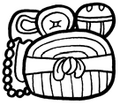| Yax Ehb Xook | |
|---|---|
 Yax Ehb Xook's glyph | |
| Ajaw of Tikal | |
| Reign | c. 90 AD |
| Predecessor | City-state established |
| Successor | Foliated Jaguar |
| Religion | Maya religion |
Yax Ehb Xook, [N 1] also known as Yax Moch Xok and Yax Chakte'I Xok, (fl. c. 90) was the dynastic founder and ajaw of the Maya city-state of Tikal. He ruled c. 90 AD. [1]
Contents
Previous estimates had placed the founder at AD 170-235 or AD 219–238. But these ranges had been derived by placing the death of the ninth ruler Chak Tok Ich'aak I who died in AD 378. In fact, Chak Tok Ich'aak I, was Tikal's fourteenth ruler and not its ninth. This earlier foundation date only reinforces Tikal's pivotal role in the genesis of Classic civilization in the Maya Lowlands, synchronizing it with developments in the Highlands and Pacific Coast that have traditionally been designated Late Preclassic but bear most of the hallmarks of Early Classic civilization. [2] [3]
